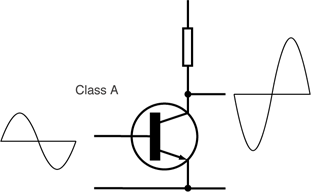Amplifiers
An electronic amplifier is a device for increasing the current, voltage or power of a signal. It does this by taking power from a power supply and controlling the output to match the input signal shape but with a larger amplitude. more...
This process invariably introduces some noise and distortion into the signal, and the process cannot be 100% efficient. Therefore amplifiers will always produce some waste heat. An idealized amplifier can be said to be "a piece of wire with gain", as the output is an exact replica of the input, but larger.
Categories
Different designs of amplifiers are used for different types of applications and signals. We can broadly divide amplifiers into three categories—small signal amplifiers, low frequency power amplifiers and RF power amplifiers. Each of these calls for a slightly different design approach, mainly because of the physical limitations of the components used to implement the amplifier, and the efficiencies that can be realised.
Implementation
Amplifiers can be implemented using transistors of various types, or vacuum tubes (valves). Other more exotic forms of amplifier are also possible using different types of devices. Such exotic amplifiers are often used for microwave or other extremely high frequency signals.
Amplifier Classes
Amplifier circuits are classified as A, B, AB and C for analog designs, and class D and E for switching designs. For the analog classes, each class defines what proportion of the input signal cycle is used to actually switch on the amplifying device:
- Class A
- 100% of the input signal is used (conduction angle a = 360° or 2π)
- Class AB
- more than 50% but less than 100% is used. (181° to 359°, π < a < 2π)
- Class AB1 is a valve amp in class AB where the grid is more negatively biased than it is in class A.
- Class AB2 is a valve amp in class AB where the grid is often more negatively biased than in AB1, and the input signal is often larger. When the drive is high enough to make the grid positive, the grid current will increase. It is possible depending on the level of the signal input for the amplifer to move from class AB1 to AB2.
- Class B
- 50% of the input signal is used (a = 180° or π)
- Class C
- less than 50% is used (0° to 179°, a < π)
This can be most easily understood using the diagrams in each section below. For the sake of illustration, a bipolar junction transistor is shown as the amplifying device, but in practice this could be a MOSFET or vacuum tube device. In an analog amplifier, the signal is applied to the input terminal of the device (base, gate or grid), and this causes a proportional output drive current to flow out of the output terminal. The output drive current is obtained from the power supply. The voltage signal shown is thus a larger version of the input, but has been changed in sign (inverted) by the amplification. Other arrangements of amplifying device are possible, but that given (common emitter, common source or common cathode) is the easiest to understand and employ in practice. If the amplifying element is linear, then the output will be faithful copy of the input, only larger and inverted. In practice, transistors are not linear, and the output will only approximate the input. Non-linearity is the origin of distortion within an amplifier. Which class of amplifier (A, B, AB or C) depends on how the amplifying device is biased—in the diagrams the bias circuits are omitted for clarity.
Read more at Wikipedia.org



